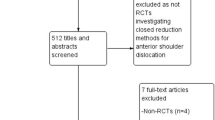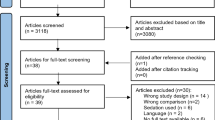Abstract
Purpose
To identify the optimal technique for closed reduction for shoulder instability, based on success rates, reduction time, complication risks, and pain level.
Methods
A PubMed and EMBASE query was performed, screening all relevant literature of closed reduction techniques mentioning the success rate written in English, Dutch, German, and Arabic. Studies with a fracture dislocation or lacking information on success rates for closed reduction techniques were excluded. We used the modified Coleman Methodology Score (CMS) to assess the quality of included studies and excluded studies with a poor methodological quality (CMS < 50). Finally, a meta-analysis was performed on the data from all studies combined.
Results
2099 studies were screened for their title and abstract, of which 217 studies were screened full-text and finally 13 studies were included. These studies included 9 randomized controlled trials, 2 retrospective comparative studies, and 2 prospective non-randomized comparative studies. A combined analysis revealed that the scapular manipulation is the most successful (97%), fastest (1.75 min), and least painful reduction technique (VAS 1,47); the “Fast, Reliable, and Safe” (FARES) method also scores high in terms of successful reduction (92%), reduction time (2.24 min), and intra-reduction pain (VAS 1.59); the traction-countertraction technique is highly successful (95%), but slower (6.05 min) and more painful (VAS 4.75).
Conclusion
For closed reduction of anterior shoulder dislocations, the combined data from the selected studies indicate that scapular manipulation is the most successful and fastest technique, with the shortest mean hospital stay and least pain during reduction. The FARES method seems the best alternative.



Similar content being viewed by others
References
Zacchilli MA, Owens BD (2010) Epidemiology of shoulder dislocations presenting to emergency departments in the United States. J Bone Joint Surg Am 92:542–549. doi:10.2106/JBJS.I.00450
Liavaag S, Svenningsen S, Reikerås O, et al (2011) The epidemiology of shoulder dislocations in Oslo. Scand J Med Sci Sport 21:e334–340.
Cunningham NJ (2005) Techniques for reduction of anteroinferior shoulder dislocation. Emerg Med Australas 17:463–471. doi:10.1111/j.1742-6723.2005.00778.x
Riebel GD, McCabe JB (1991) Anterior shoulder dislocation: a review of reduction techniques. Am J Emerg Med 9:180–188. doi:10.1016/0735-6757(91)90187-O
Alkaduhimi H, van der Linde JA, Flipsen M et al (2016) A systematic and clinical guide on how to reduce a shoulder dislocation. Turk J Emerg Med 16(4):155–168. doi:10.1016/j.tjem.2016.09.008
Liberati A, Altman DG, Tetzlaff J et al (2009) The PRISMA statement for reporting systematic reviews and meta-analyses of studies that evaluate health care interventions: explanation and elaboration. PLoS Med 6:e1000100. doi:10.1371/journal.pmed.1000100
Altman DG, Schulz KF, Moher D et al (2001) The revised CONSORT statement for reporting randomized trials: explanation and elaboration. Ann Intern Med 134:663–694. doi:10.7326/0003-4819-134-8-200104170-00012
Peck R, Devore JL (2012) Statistics: the exploration and analysis of data, 7th editio. R. Stratton, Boston
Rezende BD, Almeida JIN de, Sousa UJ de et al (2015) Glenoumeral dislocation: a prospective randomized study comparing spazo and kocher maneuvers. Acta Ortop Bras 23:192–196.
Sapkota K, Shresta B, Onta PR, Thapa P (2015) Comparison between external rotation method and milch method for reduction of acute anterior dislocation of shoulder. J Clin Diagn Res 9:RC01–R03
Turturro F, Montanaro A, Calderaro C et al (2014) Efficacy of the assisted self-reduction technique for acute anterior shoulder dislocation. Arch Orthop Trauma Surg 134:1761–1765. doi:10.1007/s00402-014-2109-2
Ghane MR, Hoseini SH, Javadzadeh HR et al (2014) Comparison between traction-countertraction and modified scapular manipulation for reduction of shoulder dislocation. Chin J Traumatol 17:93–98
Amar E, Maman E, Khashan M et al (2012) Milch versus Stimson technique for nonsedated reduction of anterior shoulder dislocation: A prospective randomized trial and analysis of factors affecting success. J Shoulder Elb Surg 21:1443–1449. doi:10.1016/j.jse.2012.01.004
Maity A, Roy DS, Mondal BC (2012) A prospective randomised clinical trial comparing FARES method with the Eachempati external rotation method for reduction of acute anterior dislocation of shoulder. Injury 43:1066–1070. doi:10.1016/j.injury.2012.01.019
Sahin N, Oztürk A, Ozkan Y, et al (2011) A comparison of the scapular manipulation and Kocher’s technique for acute anterior dislocation of the shoulder. Eklem Hast ve cerrahisi [Joint Dis Relat surgery] 22:28–32.
Sayegh FE, Kenanidis EI, Papavasiliou KA et al (2009) Reduction of acute anterior dislocations: a prospective randomized study comparing a new technique with the Hippocratic and Kocher methods. J Bone Joint Surg Am 91:2775–2782. doi:10.2106/JBJS.H.01434
Uglow MG (1998) Kocher’s painless reduction of anterior dislocation of the shoulder: a prospective randomised trial. Injury 29:135–137. doi:10.1016/S0020-1383(97)00168-X
Guler O, Ekinci S, Akyildiz F et al (2015) Comparison of four different reduction methods for anterior dislocation of the shoulder. J Orthop Surg Res 10:80
Smith SLF (2009) An investigation comparing the Oxford Chair Technique with the traditional methods of glenohumeral dislocation reduction currently implemented. Int Emerg Nurs 17:38–46. doi:10.1016/j.ienj.2008.09.004
Singh S, Yong CK, Mariapan S (2012) Closed reduction techniques in acute anterior shoulder dislocation: Modified Milch technique compared with traction-countertraction technique. J Shoulder Elb Surg 21:1706–1711. doi:10.1016/j.jse.2012.04.004
Beattie TF, Steedman DJ, McGowan A, Robertson CE (1986) A comparison of the Milch and Kocher techniques for acute anterior dislocation of the shoulder. Injury 17:349–352
Ahmed S, Singh J, Nicol M (2007) Stepped care approach to reduction of anterior shoulder dislocation in the prone position. Surgeon 5:363–367. doi:10.1016/S1479-666X(07)80089-8
Fitch RW, Kuhn JE (2008) Intraarticular lidocaine versus intravenous procedural sedation with narcotics and benzodiazepines for reduction of the dislocated shoulder: A systematic review. Acad Emerg Med 15:703–708. doi:10.1111/j.1553-2712.2008.00164.x
Gudena R, Iyengar KP, Nadkarni JB, Loh W (2011) Irreducible shoulder dislocation - A word of caution. Orthop Traumatol Surg Res 97:451–453. doi:10.1016/j.otsr.2011.02.004
Day MS, Epstein DM, Young BH, Jazrawi LM (2010) Irreducible anterior and posterior dislocation of the shoulder due to incarceration of the biceps tendon. Int J Shoulder Surg 4:83–85. doi:10.4103/0973-6042.76970
Somville FJ (2008) Plexus injury after reduction of anterior caudal dislocation of the shoulder. Acta Chir Belg 108:362–364
Stern R, Brigger A, Hoffmeyer P (2005) Pseudo-reduction of an acute anterior dislocation of the shoulder–a case report. Acta Orthop 76:932–933
Zanchetta M, Igatelli G, Dimopoulos K et al (2002) Endoluminal repair of axillary artery and vein rupture after reduction of shoulder dislocation. A case report. Minerva Cardioangiol 50:69–73
Waxman DL, France MP, Harryman DT (1996) Late lateral displacement of the humeral head after closed reduction of glenohumeral dislocation: a sign of vascular injury. Report of a case. J Bone Jt Surg Am 78:907–910
Jerosch J, Castro WH, Colemont J (1989) A lesion of the musculocutaneous nerve. A rare complication of anterior shoulder dislocation. Acta Orthop Belg 55:230–232
Pimpalnerkar A, Datta A, Longhino D, Mohtadi N (2004) An unusual complication of Kocher’s manoeuvre. BMJ 329:1472–1473
Regauer M, Polzer H, Mutschler W (2014) Neurovascular complications due to the Hippocrates method for reducing anterior shoulder dislocations. World J Orthop 5:57–61. doi:10.5312/wjo.v5.i1.57
Ahmad R, Ahmed S, Bould M (2007) Iatrogenic Fracture of Humerus - Complication of a Diagnostic Error in a Shoulder Dislocation: a Case Report. J Med Case Rep 1:41. doi:10.1186/1752-1947-1-41
Author information
Authors and Affiliations
Ethics declarations
Conflict of interest
The authors declare that they have no conflict of interest.
Funding
There is no funding source.
Ethical approval
This article does not contain any studies with human participants or animals performed by any of the authors.
Appendix 1
Appendix 1
Pubmed search
(reduct* OR reposit*) AND shoulder AND (dislocat* OR instabil*).
Embase search
(reduct* OR reposit*) AND shoulder AND (dislocat* OR instabil*).
Rights and permissions
About this article
Cite this article
Alkaduhimi, H., van der Linde, J.A., Willigenburg, N.W. et al. A systematic comparison of the closed shoulder reduction techniques. Arch Orthop Trauma Surg 137, 589–599 (2017). https://doi.org/10.1007/s00402-017-2648-4
Received:
Published:
Issue Date:
DOI: https://doi.org/10.1007/s00402-017-2648-4




